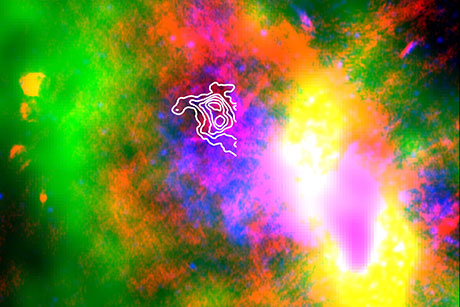Each supernova enriched the interstellar dust with more heavy materials, until we finally reached the current composition, from which we are all made (carbon, oxygen, iron, etc.). However, until now it was not possible to observe the process and it remains theoretical. Now the smoking, or dusty, gun has been photographed

Looking deep into the center of the Milky Way, astronomers managed to make the first direct observations - using a red telescope mounted on a Boeing 747 - of the cosmic building blocks of the dust created by an ancient supernova explosion.
"The dust itself is important because it is the material from which the stars and planets such as the Sun and the Earth were formed respectively. Because of this, the question of its origin is a very important question," says lead researcher Ryan Lau, a postdoctoral fellow at the Cornell Center for Astronomy in an article published on March 19 in the journal "Science Express." "Our work reinforces the theory that supernovae produce the dust we see in galaxies in the early universe," he said.
Lau explains that one of the biggest questions in astronomy is why galaxies formed up to a billion years after the big bang contain so much dust? The leading theory is that supernovae, stars that explode at the end of their lives and release large amounts of metal-rich materials, in turn provide basic materials such as dust, iron, iron and carbon.
The astronomers examined Sagittarius A East, the remnants of a ten-thousand-year-old supernova located near the center of our galaxy. Lau says that when a supernova explodes, the materials in its center spread out and create dust. The phenomenon has been observed in some remnants of young supernovae - such as SN1987A in Cassiopeia. In the turbulent environment of the supernova, scientists expect that the rapidly produced dust will also be destroyed. "The forecast was theoretical," says Lau. "There was no direct evidence that dust survived the environment of the supernova remnant - until now, which is why observations of old supernovae are so important," he said.
The photograph was taken using the FORCAST (the Faint Object Infrared Camera Telescope) telescope mounted on SOFIA (the Stratospheric Observatory for Infrared Astronomy) - a Boeing 747 aircraft that has been converted for this purpose and is operated in cooperation between NASA, the German Space Center and several universities. It is the largest airborne astronomical observatory in the world. Currently, no space telescope is able to observe light in waves in the far infrared range, while ground-based telescopes cannot observe these frequencies due to their absorption by the Earth's atmosphere.

3 תגובות
in the large magellanic cloud
Supernova 1987A is in the Magellanic Cloud, not Cassiopeia